Dwindling yield has pushed Pampore’s saffron growers to a new low and sections within the government wish they start producing corms that are required for introducing the crop to other districts. Shams Irfan reports fall of saffron economy at the peak of Saffron rule
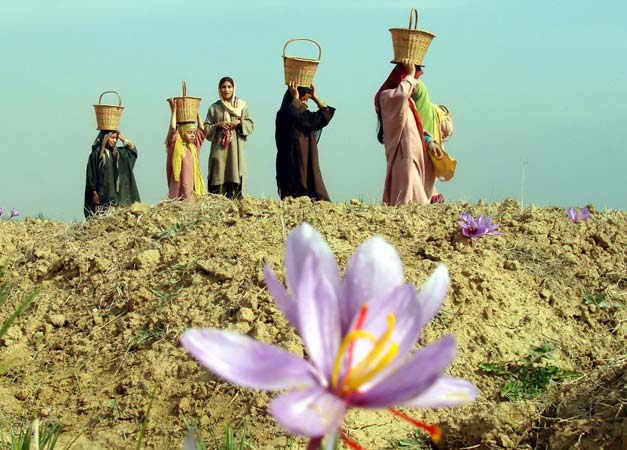
Ghulam Nabi Ganie, 55, is sitting idle on a large stone carved veranda, outside his sprawling house in Chandhara village. Built in late 50’s, Ganie’s house is still counted among the most lavish household in Habba Khatoon’s village. The first vehicle – a second-hand Fait 1100 Delight – that rolled into Chandhara’s pukka roads in 1966 belonged to Ramzan Haji, Ganie’s uncle.
One has to take a steep road to climb out of the village to reach the main road, connecting it with the Srinagar-Jammu highway.
Ganie, a third generation cultivator, who owns 30 kanals of saffron land, mostly on the western fertile karewas of the village, is an unhappy man. He wears a tense look on his face. The landscape around him is changing fast and he, like his fellow cultivators, is struggling to cope up with the change.
Harvested between ending October to mid-November, winters are usually relaxed in Chandhara, as most of the household in the village depend on saffron cultivation for their livelihood.
Otherwise buzzing with activity, Chandhara now wears a deserted look during day time as most of the villagers are out in nearby towns seeking menial jobs.
Ganie takes a deep breath, and looks into the vast sky overlooking the golden karewas, where he used to work with his father. “It’s a race against time to save saffron,” says Ganie. “This season I couldn’t manage to retrieve my costs even.”
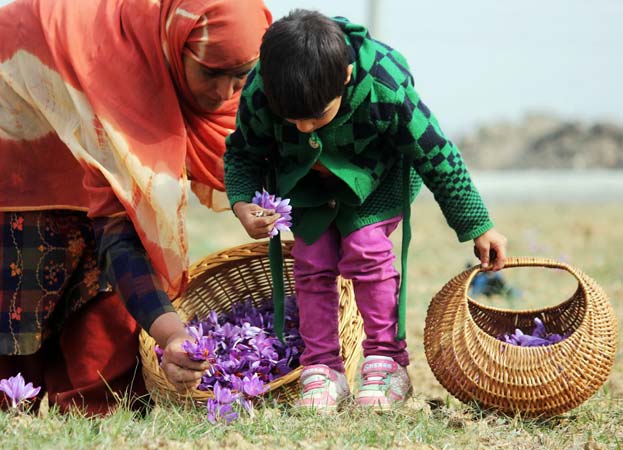
In 1996 the land under saffron cultivation was 5400 hectares with a collective yield of 16 metric tonnes.
This was the highest yield ever since state’s agriculture department began recording the highs and lows of the world’s most precious spice in 1967. At that time, per hectare yield was 3 kgs.
But in 2006, both the areas under cultivation and yield fell drastically. With just 2800 hectares of cultivable land available now, total produce fell to just six metric tonnes.
Free Fall
Ganie takes out a small pocket size dairy from his pocket carefully and shuffles through pages one-by-one. The dairy contains record of his produce and earning. In 2012, Ganie says, “30 kanals of land produced 248 tolas (1 tola is 10 grams) of saffron.” It was the highest in last few years.
Back in 70s, when Ganie lived in a joint family with his father and four uncles, he used to visit Delhi and Mumbai to sell their produce. “Then, we collectively owned more than 300 kanals,” says Ganie.
Every room of Ganie’s three storey house would be filled with saffron flowers, dried after extraction during long wintery nights. “Throughout the winters we used to sit and extract saffron from these flowers,” remembers Ganie. “The yield was usually in quintals. So we would employ people from entire village to help us with extraction.”
But then times changed, and so did the produce.
In 2012, Ganie sold his produce to a local trader earning him just Rs 2.17 lakh. “I had spent 80 thousand on labour and fertilizers,” says Ganie.
In 2013 and 2014, Ganie’s produce came down drastically to 54 and 80 tolas respectively. “Though the selling price was relatively higher, but low productivity couldn’t retrieve even labour costs,” says Ganie.
Ask him why such a drastic change in produce and Ganie looks heavenwards before answering. “Khudah chuh naraaz (God is angry). That is why there is either flood or draught,” says Ganie.
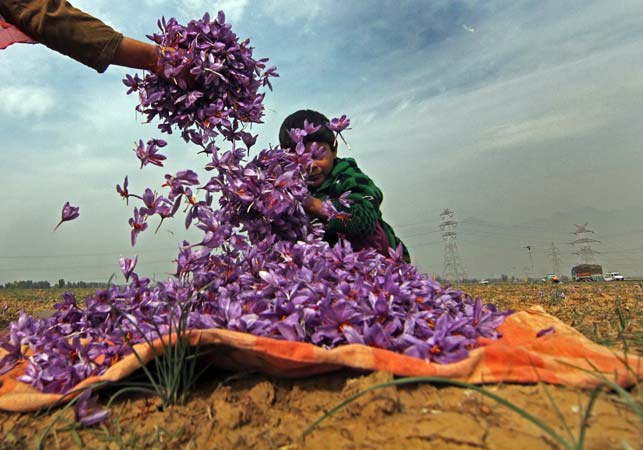
National Saffron Mission
Under the ambitious Rs 400.11 crore National Saffron Mission scheme, that was finalized in 2010, and implemented in 2011, a number of majors were suggested to give boost to the crop.
A farmer based partnership where central government bears 75 percent of the costs, while rest 25 percent is borne by the farmers.
Since the traditional way of cultivation is labour intensive, draining a large portion of a farmer’s income on preparation of fields, government introduced mechanised de-weeding machines on subsidised rates.
“In the first year we had kept some 500 machines, but only 60 farmers turned up to buy them,” said Prof Firdous Ahmad Nahvi, chief scientist, National Saffron Mission.
But once the benefits of these machines became known to farmers, the next years, against 10 machines kept by the agriculture department, a demand of around 500 machines was received.
Apart from de-weeding machines, GoI also provided dryers to the farmers so that the quality of the produce is enhanced.
Under NSM, a farmer sows 50 plants per square meter compared to traditional way where 15 to 20 plants were grown in a square meter.
“The traditional way of plantation is prone to diseases,” feels Prof Nahvi, who is associated with NSM right from the start.
Other factor that Prof Nahvi feels have affected saffron production is erratic weather pattern since 1999. “The amount of precipitation is erratic. Kashmir now receives more rainfall during summers, which is bad for saffron,” feels Prof Nahvi. “Saffron is like a desert camel. It survives on less water. Or let’s say limited water.”
Over the years the techniques and methods of cultivation has largely remained traditional. Which experts believe added to the decline of the productivity. “Unfortunately people are not taking saffron cultivation as farming system. It is still done in a traditional way,” says Prof Nahvi.
In contrast, horticulture sector is better organized, as farmers are more conscious about diseases affecting their crops and measures to be taken to save their produce. “You will see how farmers who grow apples spray their orchards with pesticides etc. But this is missing in Saffron,” said Prof Nahvi.
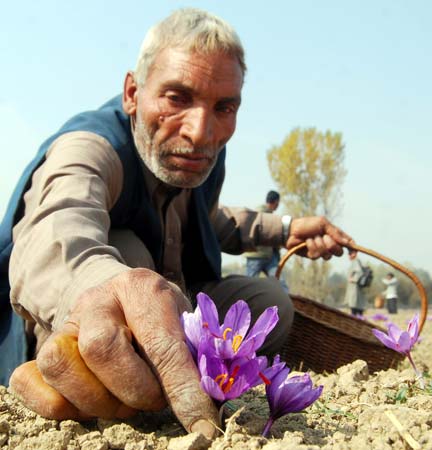
Problems
One of the major reasons for Kashmiri saffron’s fall from grace is lack of proper marketing. There is no lab to check the quality or saffron in Kashmir. Traders, who sell their produce in the international market, have to get their produce tested either at RAL Jammu or in Delhi.
The only functional lab in Kashmir is at Lal Mandi, but it is not up to the mark.
Irrigation Woes
Under NSM, 124 bore-wells were sanctioned for construction to regulate the irrigation system of saffron fields. So far only 90 were constructed. But they are not functional yet.
Normally in April, May, June and July, Kashmir witnesses 80 mm of precipitation, but since 1999, due to climatic change, or erratic weather pattern, there is 160 mm of precipitation. “Too much of rainfall is bad for saffron cultivation,” said Prof Nahvi.
Phenomenology of crop changes because of erratic weather conditions. “The excess rainfall results in the flower loss,” said Prof Nahvi.
Flower Loss, Not Failure
When we say we had no produce or less produce, it essentially means a farmer has a flower loss, rather than a failure. “The corm or the seed of saffron, which is sold for Rs 15000 per quintal, can compensate the flower loss if a farmer is smart,” feels Prof Nahvi.
As government is mulling to introduce saffron in 16 out of 22 districts of Kashmir, there is going to be a huge demand for saffron corm. “And Pampore, with best quality corm in the world can become hub for seeds,” feels Prof Nahvi.
There is a standing demand for 200 quintals of saffron seeds as of now which is not met.
Experts claim that the NSM scheme was formulated in such a way that even if there is a flower loss a farmer can still survive or rather earn good by selling the corms.
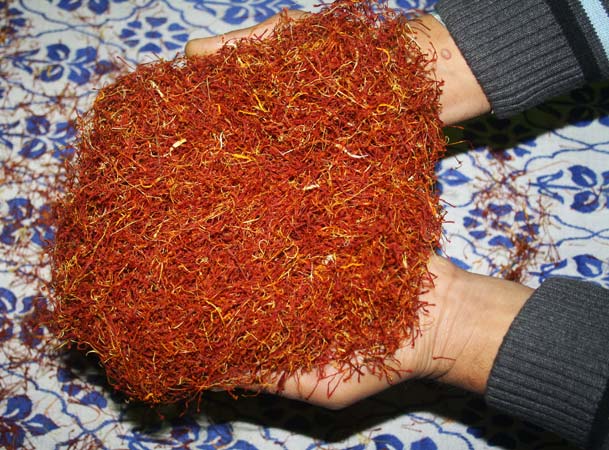
End Product: The stigmas of saffron cultivated in Kashmir are extremely long and with a thicker head.
Growing a Jungle
In last one decade almost 50 percent of the areas under saffron cultivation got converted into residential colonies. In 1996, the total area under saffron cultivation was 5400 hectares, against now 3715 hectares in 2015.
Ironically, there is a Saffron Colony in Pampore peripheries build entirely on saffron land.
In Ganie’s village, as saffron failed to keep pace with the fast changing world outside, and instead began eating into a farmers savings, conversion of saffron fields in agriculture, horticulture and for residential purpose saw a massive surge.
“In next fifteen years you will find saffron only in books and pictures, not in the fields,” said Ganie, while holding a basket full of saffron flower he had managed to bring home from 30 kanals. “We used to gift this much to kids during our glory days,” said Ganie, holding the basket in air with eyes full of tears.
The post Mission Saffron appeared first on Kashmir Life.